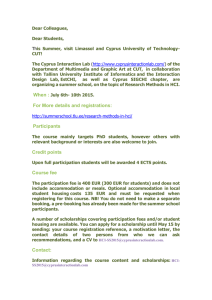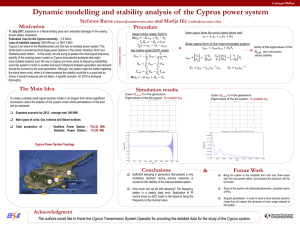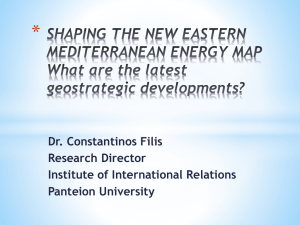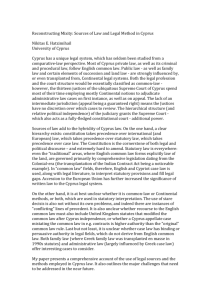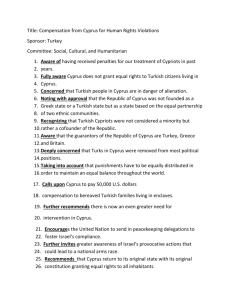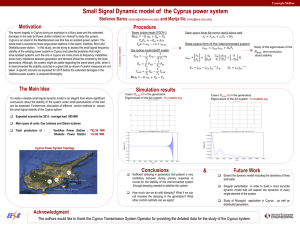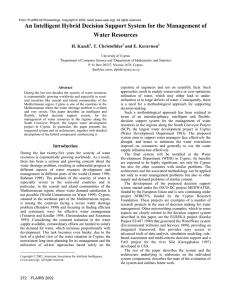UCL Grand Challenge of Sustainable Cities Symposium:
advertisement
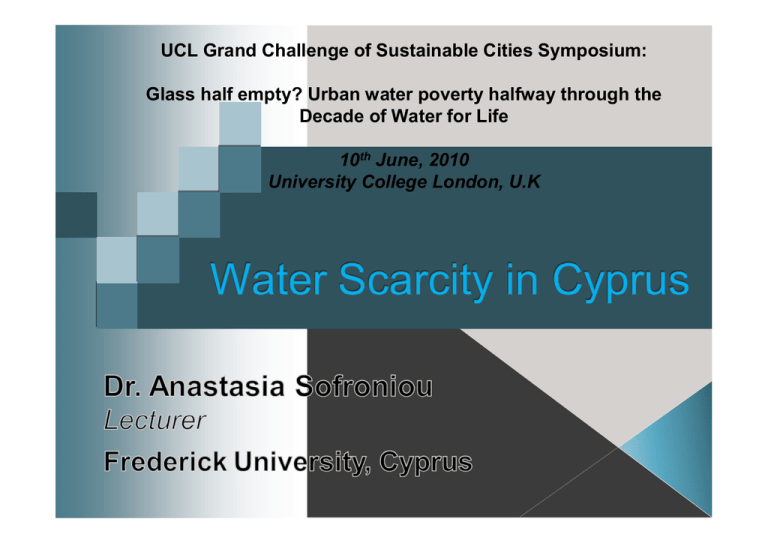
UCL Grand Challenge of Sustainable Cities Symposium: Glass half empty? Urban water poverty halfway through the Decade of Water for Life 10th June, 2010 University College London, U.K 2 Water scarcity has always been a very serious problem for Cyprus – Cyprus and Malta are the “water poor” countries of Europe Semi-arid climate Limited water resources › Depend mainly on rainfall › Scarce & expensive to exploit Unevenly distributed rainfall Frequent occurrence of droughts Many small catchments, but no perennial flow 3 Official population of Cyprus estimated at 885,600 at the end of 2008 (75.5% were Greek Cypriots, 10% Turkish Cypriots and 14.5% were foreign residents) Climate models predict rise in temperature and increase in the intensity and frequency of extreme drought events These conditions, coupled with increased water demands are worsening the water scarcity problem in Cyprus Stepped drop of precipitation in the early 70s 4 Kouris Dam April 2004 Stored Water Volume = 115Mm3 Kouris Dam Dec 2008 SWV = 1Mm3 The 2008 winter was extremely dry and the inflow to the reservoirs was only 18,7 MCM Water reserves of underground aquifers were drastically reduced and water storage in the dams had reached dangerously low levels 5 Figures represent water demand by sector (Agriculture, Domestic, Industrial and Environmental) and the water sources for each sector respectively. Water demand is more than the supply and water needs, especially for irrigation, are rarely satisfied › Since 1996, water demand for irrigated agriculture was satisfied only in 2004 when all dams over-spilled 6 Water Demand share by sector and contribution to GDP for the year 2006 •The Industrial (secondary) sector which includes manufacturing, energy production and construction produces19% of the gross domestic product (GDP) and the total water demand share as abovementioned 1,5%. •The tertiary (service) sector contributes about 78% of the gross domestic product. • In 2006 the revenues of tourism amounted to 1,755.3 million Euros which represents 14% of the GDP for that particular year and around 7% of the total water demand share. •The striking imbalance of economic return on water input can be seen in the agricultural (primary) sector. Agriculture accounts for 66% of the annual water demand with a measly contribution of 3% to the country’s economy. 7 8 Integrated & sustainable approach to water management Strategic planning › Long term actions to meet future demands under scarcity conditions › Short term actions to face a particular drought event within the existing framework Applied to all Government Water Works (GWW) on a yearly basis, depending on climatic conditions Includes restrictions to water use & other water demand and supply management measures Water from GWW allocated to different uses with priority to domestic sector, including tourism Remaining quantity allocated to agriculture using a quota 9 system & penalty charges for over-consumption Allocation of water from GWW Implementation embarked in the late 60s Objective: to satisfy in a sustainable way the different users of water and safeguard human & other life Measures implemented to increase water availability and decrease water demand 10 Accumulated Storage Capacity (MCM of water) Increased dams capacity Drilled boreholes for domestic and irrigation purposes Constructed water treatment plants (already desalination makes up for almost 40% of domestic water supply with a clear upward trend) Recharge works (recycled water used to recharge depleted aquifers in order to reduce the effects of sea intrusion) 11 Installed improved on farm irrigation systems Constructed modern, efficient conveyance and distribution systems Imposed water charges for domestic and irrigation water Despite the significant measures, available water was not enough Climatic conditions: A drop of 20% in precipitation resulting to a 40% Inflow of water to the Dams (MCM) reduction in surface runoff More frequent occurrence of extreme drought events Rapid increase in population and tourist arrivals in Cyprus Deterioration of groundwater quality and quantity: In the attempt to meet the increasing water demand or to mitigate drought effects, groundwater resources 12 have been heavily over-pumped Government forced to turn to seawater desalination in 1997 One mobile & two permanent plants currently in operation › Additional plants in construction / planning phase Objective is to eliminate the dependency of potable water on rainfall Despite environmental & financial costs, experience has shown that desalination remains the only means of achieving water security and independence of domestic water from climatic behaviour 13 Recycled water for irrigation and recharge purposes is a growing resource in Cyprus Grey water is a means of reducing water consumption in households (water used for washing is collected in a separate system and reused after filtration for toilet flushing and domestic irrigation) Virtual Water Concept: is the volume of water used in the production process of a commodity (good or service). The amount of water in a product, not in its real sense but in its virtual sense, whereby the virtual metaphor refers to the invisible water that is required during the production process of a certain product, measured at the place of production. 14 It is much more preferable for water scarce countries to import virtual water via food products rather than using the limited domestic water resources for their production. This is called Virtual Water Trade and it allows relief to high water stressed countries. Example from Zoumides’ recent virtual crop studies of Cyprus (Zoumides, 2010). Cyprus utilises barley both from domestic and foreign origin. The virtual water content of one ton of barley produced within Cyprus is 2237 m3 whereas the same quantity of imported barely from Ukraine requires only 713 m3. country saves water by importing rather than producing all the required barley quantity itself. 15 Metering of water consumption Water charges on a volumetric basis Programs to reduce distribution losses Installation of improved on farm irrigation systems Measures to promote a water-saving culture & efficiency of water use Water rationing during periods of drought Subsidies for saving potable water 16 Cyprus is progressing towards full implementation of the WFD Committed to the efficient and effective implementation of the WFD principles and provisions WFD came into force in Dec 2000 and › Establishes a legal framework to protect and restore clean water across Europe › Ensures long-term and sustainable use of water › Sets the goal of achieving “good status” for all of Europe's surface waters and groundwater by 2015 17 18 In response to the acute drought Cyprus was faced with in 2008, a series of emergency measures were applied: › Transfer of potable water from Greece, using tankers › Almost 100% ban on water supply to agriculture › Strict restrictions on drinking water supply to households (only 36 hrs per week) › Extension of the existing desalination plants capacity and installation of mobile ones › Treatment of the Garillis aquifer to potable water › Use of new boreholes & purchase of water from private boreholes for domestic supply › Intensification of water saving promotion campaigns and financial incentives for saving potable water Restrictions on the supply of drinking water have only been lifted recently, 2nd February 2010 19 Basic objectives of the Water Policy of Cyprus should be: To keep in check increasing demands of water by appropriate pricing mechanisms to apply irrigation water more in line with actual plant requirements, to adjust cropping patterns in favour of crops with lower water requirements (virtual water concept) or promote crops with considerable less need of irrigation water for their growth and production to reduce losses of domestic water from urban water supply distribution systems to increase the efficiency of domestic use to explore possible rainwater utilisation to intensify water saving promotion campaigns to provide financial incentives for saving potable water to maintain and enhance the quality of water and to introduce new efficient management procedures through the establishment of one Water Entity. 20 21 Important decision-making tools for the instrumentation of an integrated water resources management The Water Development Department (WDD) of Cyprus could benefit from models related to desalination, water recycling, dam operation management, etc. 22 Optimisation of the operations of the desalination plants (economic parameters) › Monthly output based on demand Dam operation management (objective: to minimise losses) › Transfer from one dam to other Decision making tool for the allocation of recycled water › Allocation between ponds, irrigation, aquifer recharge 23 Future presents many challenges for Cyprus › Rapid social changes › Further economic development › Climate change › Water scarcity & droughts › Escalating water demands in a continuously changing environment All necessary measures must be taken to ensure water security now and in the future through an integrated multi-objective approach for water management 24 25

